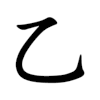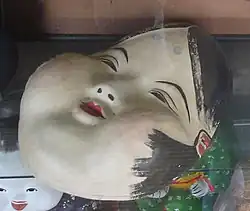乙
| ||||||||
| ||||||||
Translingual
| Stroke order | |||
|---|---|---|---|
 | |||
Han character
| Stroke order | |||
|---|---|---|---|
乙 (Kangxi radical 5, 乙+0, 1 stroke, cangjie input 弓山 (NU), four-corner 17710)
- Kangxi radical #5, ⼄.
Derived characters
References
- Kangxi Dictionary: page 83, character 15
- Dai Kanwa Jiten: character 161
- Dae Jaweon: page 167, character 7
- Hanyu Da Zidian (first edition): volume 1, page 47, character 4
- Unihan data for U+4E59
Chinese
Glyph origin
| Historical forms of the character 乙 | |||||||||||||||||||||||||||||||||||||||||||||||||||||||||||||||||||||||||||||||||||||||||||||||||||||||||||||||||||||||||||||||||||||||||||||||||
|---|---|---|---|---|---|---|---|---|---|---|---|---|---|---|---|---|---|---|---|---|---|---|---|---|---|---|---|---|---|---|---|---|---|---|---|---|---|---|---|---|---|---|---|---|---|---|---|---|---|---|---|---|---|---|---|---|---|---|---|---|---|---|---|---|---|---|---|---|---|---|---|---|---|---|---|---|---|---|---|---|---|---|---|---|---|---|---|---|---|---|---|---|---|---|---|---|---|---|---|---|---|---|---|---|---|---|---|---|---|---|---|---|---|---|---|---|---|---|---|---|---|---|---|---|---|---|---|---|---|---|---|---|---|---|---|---|---|---|---|---|---|---|---|---|---|
| Shang | Western Zhou | Warring States | Shuowen Jiezi (compiled in Han) | Liushutong (compiled in Ming) | |||||||||||||||||||||||||||||||||||||||||||||||||||||||||||||||||||||||||||||||||||||||||||||||||||||||||||||||||||||||||||||||||||||||||||||
| Oracle bone script | Bronze inscriptions | Chu slip and silk script | Small seal script | Transcribed ancient scripts | |||||||||||||||||||||||||||||||||||||||||||||||||||||||||||||||||||||||||||||||||||||||||||||||||||||||||||||||||||||||||||||||||||||||||||||
 |
 |
 |
 |
 | |||||||||||||||||||||||||||||||||||||||||||||||||||||||||||||||||||||||||||||||||||||||||||||||||||||||||||||||||||||||||||||||||||||||||||||
| |||||||||||||||||||||||||||||||||||||||||||||||||||||||||||||||||||||||||||||||||||||||||||||||||||||||||||||||||||||||||||||||||||||||||||||||||
|
References: Mostly from Richard Sears' Chinese Etymology site (authorisation),
| |||||||||||||||||||||||||||||||||||||||||||||||||||||||||||||||||||||||||||||||||||||||||||||||||||||||||||||||||||||||||||||||||||||||||||||||||
Unknown. Different ancient texts propose different origins.
- Pictogram (象形) – a developing plant (Shuowen).
- Pictogram (象形) – the intestine of a fish (Erya).
- Pictogram (象形) – the gill bone of a fish (Liji Zhengyi (《禮記正義》)
The character should not be confused with 𠃉 > 鳦.
Pronunciation
Definitions
乙
- The second of the ten heavenly stems (天干 (tiāngān))
- second; 2; B; II; beta (used for unnamed people or objects, to enumerate headings in a list, for grades, etc.)
- (chemistry) eth-; ethyl
- 乙烷 ― yǐwán ― ethane
- (literary, formal) one
- a surname
- (Cantonese) This term needs a translation to English. Please help out and add a translation, then remove the text
{{rfdef}}. (Classifier: 隻/只 c)
Coordinate terms
Compounds
- 三氯乙烷
- 三氯乙烯 (sānlǜyǐxī)
- 丹鉛甲乙/丹铅甲乙
- 丹黃甲乙/丹黄甲乙
- 乙乙
- 乙力
- 乙士
- 乙夜 (yǐyè)
- 乙字庫/乙字库
- 乙帳/乙帐
- 乙干
- 乙弗
- 乙旃
- 乙更
- 乙榜
- 乙正
- 乙炔 (yǐquē)
- 乙烯 (yǐxī)
- 乙烷 (yǐwán)
- 乙科
- 乙第
- 乙等特考
- 乙腦/乙脑 (yǐnǎo)
- 乙覽/乙览
- 乙速孤
- 乙選/乙选
- 乙部
- 乙酸 (yǐsuān)
- 乙醇 (yǐchún)
- 乙醛 (yǐquán)
- 乙醚 (yǐmí)
- 乙鳥/乙鸟
- 令乙
- 勾乙
- 厶乙
- 圖乙/图乙
- 塗乙/涂乙
- 天乙
- 太乙
- 太乙壇/太乙坛
- 太乙宮/太乙宫
- 太乙數/太乙数
- 太乙爐/太乙炉
- 太乙神針/太乙神针
- 太乙舟
- 孔乙己
- 小乙
- 左乙
- 張甲李乙/张甲李乙
- 某乙
- 氯乙烯 (lǜyǐxī)
- 泰乙
- 獨乙/独乙
- 玄乙
- 甲乙
- 甲乙問/甲乙问
- 甲乙帳/甲乙帐
- 甲乙科
- 甲乙膏
- 白乙
- 聚乙烯 (jùyǐxī)
- 聚苯乙烯 (jùběnyǐxī)
- 苯乙烯 (běnyǐxī)
- 越鳧楚乙/越凫楚乙 (yuèfúchǔyǐ)
- 面乙
- 飛乙/飞乙
- 魚乙/鱼乙
- 鳧乙/凫乙
- 鴻乙滿紙/鸿乙满纸
Descendants
- → Zhuang: iet
Pronunciation
Definitions
乙
Pronunciation
Definitions
乙
Etymology 4
From 笏.
Pronunciation
Japanese
Readings
Compounds
Etymology 1
| Kanji in this term |
|---|
| 乙 |
| おつ Grade: S |
| goon |
Originally from Middle Chinese 乙 (MC 'it), arising from the proper noun sense. Appears in texts from at least 833 CE.[1]
Proper noun
乙 • (Otsu)
Noun
乙 • (otsu)
- something B
- the second item of any ordered list
- (music) one tone lower than the note indicated by 甲 (kō, “something A”)
- (by extension from the musical sense) a lower, sonorous and moving sound or tone
- (noh theater) in noh musical accompaniment, a specific kind of muffled drum beat played by striking the head of the taiko drum and keeping the mallet pressed against the head
- (Kansai dialect, slang) a stupid person, someone who is slow on the uptake
- (rare, possibly archaic) the state or circumstances of a thing
- (rare, possibly archaic) dressing up in an odd fashion
Etymology 2
| Kanji in this term |
|---|
| 乙 |
| おつ Grade: S |
| goon |
By extension from the moving tone noun sense. Appears in texts from the late Edo period, in the early 1800s.[1]
Adjective
乙 • (otsu) -na (adnominal 乙な (otsu na), adverbial 乙に (otsu ni))
- out of the ordinary, strange or unusual in an interesting or stylish way
- strange, odd, weird
-
:ja:東海道中膝栗毛 (Tōkaidōchū Hizakurige, “Footing It along the Tokaido Road”, or “Shank's Mare”), serial published 1802-1814:
- ヲヤ弥次さん、おつな手つきをしておめへ何をする
- Oya Yaji-san, otsu na tetsuki o shite omē nani o suru
- Oy, Yaji, what do you think you're doing with your weird way of using your hands?
- ヲヤ弥次さん、おつな手つきをしておめへ何をする
-
:ja:東海道中膝栗毛 (Tōkaidōchū Hizakurige, “Footing It along the Tokaido Road”, or “Shank's Mare”), serial published 1802-1814:
Inflection
| Stem forms | |||
|---|---|---|---|
| Imperfective (未然形) | 乙だろ | おつだろ | otsu daro |
| Continuative (連用形) | 乙で | おつで | otsu de |
| Terminal (終止形) | 乙だ | おつだ | otsu da |
| Attributive (連体形) | 乙な | おつな | otsu na |
| Hypothetical (仮定形) | 乙なら | おつなら | otsu nara |
| Imperative (命令形) | 乙であれ | おつであれ | otsu de are |
| Key constructions | |||
| Informal negative | 乙ではない 乙じゃない |
おつではない おつじゃない |
otsu de wa nai otsu ja nai |
| Informal past | 乙だった | おつだった | otsu datta |
| Informal negative past | 乙ではなかった 乙じゃなかった |
おつではなかった おつじゃなかった |
otsu de wa nakatta otsu ja nakatta |
| Formal | 乙です | おつです | otsu desu |
| Formal negative | 乙ではありません 乙じゃありません |
おつではありません おつじゃありません |
otsu de wa arimasen otsu ja arimasen |
| Formal past | 乙でした | おつでした | otsu deshita |
| Formal negative past | 乙ではありませんでした 乙じゃありませんでした |
おつではありませんでした おつじゃありませんでした |
otsu de wa arimasen deshita otsu ja arimasen deshita |
| Conjunctive | 乙で | おつで | otsu de |
| Conditional | 乙なら(ば) | おつなら(ば) | otsu nara (ba) |
| Provisional | 乙だったら | おつだったら | otsu dattara |
| Volitional | 乙だろう | おつだろう | otsu darō |
| Adverbial | 乙に | おつに | otsu ni |
| Degree | 乙さ | おつさ | otsusa |
Etymology 3
| Kanji in this term |
|---|
| 乙 |
| おつ Grade: S |
| goon |
| Alternative spelling |
|---|
| o2 |
Derived as aggressive clipping of お疲れ様です (otsukaresama desu, used as a kind of greeting at work, literally “that's honorable exhaustion (from hard work)”). The use of 乙 for the spelling is an example of phonetic ateji (当て字).
Pronunciation
- IPA(key): [o̞t͡sɨᵝ]
Etymology 4
| Kanji in this term |
|---|
| 乙 |
| きのと Grade: S |
| kun’yomi |
Compound of 木 (Ki, “Wood”, one of the Five Elements) + の (no, attributive marker) + 弟 (oto, “younger brother”).
Proper noun
乙 • (Kinoto)
Etymology 5
| Kanji in this term |
|---|
| 乙 |
| おと Grade: S |
| kun’yomi |
| Alternative spelling |
|---|
| 弟 |

Cognate with the initial oto- in 劣る (otoru, “to be less than; to be younger than”), 落とす (otosu, “to drop something”).[3][1] Also the first element in 弟 (otōto, “younger brother”).
First attested in the Kojiki of 712.[4]
This is distinct from the initial oto- in 乙女 (otome), which can instead be traced to an earlier woto- root, cognate with 復つ (wotu).
Pronunciation
- IPA(key): [o̞to̞]
Noun
乙 • (oto)
- [from 712] (archaic) a younger sibling
- [from late 1500s] (archaic) the youngest sibling
- Synonym: 乙子 (otogo)
- [from late 1500s] (archaic) clipping of 乙娘 (oto musume) a young woman
- [from late 1500s] (archaic, Noh theater) clipping of 乙御前 (oto goze): a stock character in 狂言 (kyōgen) comic interludes, played as a plump and clumsy but earnest young woman
- Synonyms: おたふく (otafuku), おかめ (okame)
Prefix
乙 • (oto-)
References
- Shōgaku Tosho (1988) 国語大辞典(新装版) [Unabridged Dictionary of Japanese (Revised Edition)] (in Japanese), Tōkyō: Shogakukan, →ISBN
- Matsumura, Akira, editor (2006), 大辞林 [Daijirin] (in Japanese), Third edition, Tōkyō: Sanseidō, →ISBN
- Shinmura, Izuru, editor (1998), 広辞苑 [Kōjien] (in Japanese), Fifth edition, Tōkyō: Iwanami Shoten, →ISBN
- “弟・乙”, in 日本国語大辞典 (Nihon Kokugo Daijiten, “Nihon Kokugo Daijiten”) (in Japanese), concise edition, Tōkyō: Shogakukan, 2000
Korean
Middle Korean
Old Korean
Etymology 1
From a Late Middle Chinese pronunciation of 乙 (MC 'it), which lenited coda /-t/ to /-r/.[1]
Usage notes
Generally believed to have been pronounced as *-r, based both on internal evidence and the Chinese etymon. Old Korean 尸 (*-l) and 乙 (*-r) both merged unconditionally into *-l in Middle Korean, but the two phonograms were consistently distinguished in Old Korean until the late thirteenth century. Because Old Korean reconstructions are conventionally romanized using their Middle Korean reflex, the phonologically erroneous reconstruction *-l is often used as a shorthand.
Alternative forms
- 肹 (*-(u)r, *-hur)
Particle
乙 (*-(u)r)
- Accusative case marker
- 1120, King Yejong of Goryeo, “悼二將歌 (Doijang-ga)”, in 平山申氏系譜 (Pyeongsan Sin-ssi Gyebo) [Genealogy of the Pyeongsan Sin descent group]:
Usage notes
In Middle and Modern Korean, the allomorph taken by the accusative marker after a vowel may be 를 (-reul) instead of ㄹ (-l), especially in formal speech. This is the result of reduplication of the particle and is unlikely to have been present in Old Korean, although the phonologically opaque nature of the orthography makes it difficult to tell for sure.
In "Middle Old Korean", the late first-millennium stage of Korean represented by about a dozen mostly eighth-century poems, the accusative particle was consistently written with the phonogram 肹. 乙 has become dominant by the twelve poems of the tenth-century monk Gyunyeo, however, and 肹 is virtually not attested at all by the second millennium. There seems to be no semantic difference involved. Whether this represents a phonetic shift or simply a change in orthographic practice is unknown, although 肹 and 乙 had differing Middle Chinese initials.[2][3]
Descendants
References
- Alexander Vovin, Old Korean and Proto-Korean *r and *l revisited
- 이승재 (Yi Seung-jae) (2000) “차자표기 자료의 격조사 연구 [chajapyogi jaryoui gyeokjosa yeon'gu, A study of case markers in Sinographic sources]”, in Gugeo gungmunhak, volume 127, pages 107—132
- 황선엽 (Hwang Seon-yeop) (2008) “삼국유사와 균여전의 향찰 표기자 비교 [samgugyusawa gyunyeojeonui hyangchal pyogija bigyo, A comparison of the orthography of the hyangchal of the Samguk yusa and the Gyunyeo-jeon]”, in Gugeohak, volume 51, pages 279—311












































































































































